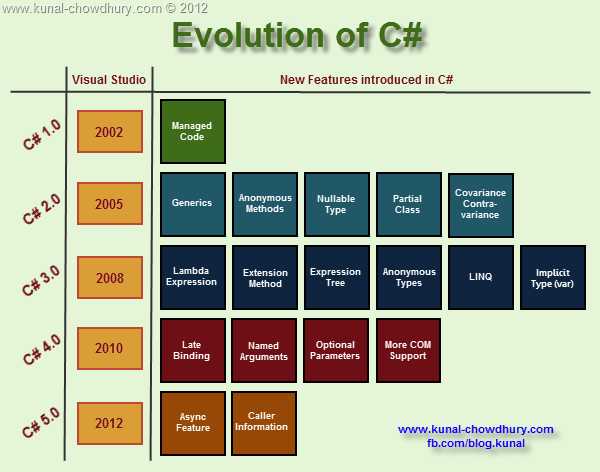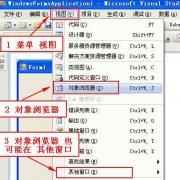Visual C#每一次新版本的变化
What‘s New in Visual C# .NET 2003[Visual Studio .NET 2003]
What‘s New in Visual C# 2005
What‘s New in Visual C# 2008
What‘s New in Visual C# 2010
What‘s New for Visual C# in Visual Studio 2012
What‘s New for Visual C# 2015
=== ================================================================================================================================================
Evolution of C# (1.0 – 5.0) – What are the New Features Introduced in C#
C# is not new to us. We are using it since Visual Studio 2002. Currently it is in released version 4.0 and C# 5.0 is on the way to release with Visual Studio 2012. Though we are using it since a long time, but many of us don’t know the new features that has been introduced in each new release.
This post will cover the “Evolution of C#” from version 1.0 to version 5.0 along with the new features and respective Visual Studio version. Bookmark this post for future reference and share it to your network and help others to know.
C# 1.0Microsoft released the first version of C# with Visual Studio 2002. Use of Managed Code was introduced with this version. C# 1.0 was the first language that developer adopted to build .NET applications.
C# 2.0Microsoft released the second version of C# language with Visual Studio 2005. C# 2.0 has three new features introduced in this edition which helped the developers to code their applications in more generic way. Here are the new features that was introduced with C# 2.0:
Generics
Anonymous Methods
Nullable Type
Partial Class
Covariance and Contra-variance
C# 3.0Visual Studio 2008 came with C# version 3.0 and it has a bunch of new features. It was the life changing language for Microsoft platform developers to build their applications. Till now, many developers are still using this version to build their apps. Here are the new features that came with C# 3.0:
Lambda Expression
Extension Method
Expression Tree
Anonymous Types
LINQ
Implicit Type (var)
C# 4.0Though C# 4.0 was released with Visual Studio 2010 with .NET Framework 4, but very few developers uses it’s new features till date. Keep in mind that, it is the latest release version. Here is a list of new features of C# that came with this version:
Late Binding
Named Arguments
Optional Parameters
More COM Support
C# 5.0Visual Studio 2012 is coming up with C# 5.0 and it will be available within next few months in 2012. The release candidate (RC) version is available for you to try out the new features. Here are two new features that is coming up with C# 5.0:
Async Feature
Caller Information
Infographic of C# EvolutionHere is the infographic of “Evolution of C#” and the new features introduced in different releases of C# and Visual Studio IDE, which you can bookmark for your future reference:

Don’t forget to share this post in your network, friends and colleagues. Help them to keep this bookmarked for their future reference too.
Last but not least, connect with me on Twitter and Facebook for technical updates and articles news. Also subscribe to my blog’sNewsletter to get all the updates delivered directly to your inbox. We won’t spam or share your email address as we respect your privacy.
=================================================================================================================================================
List of new features in C#2.0, 3.0 and 4.0
Complete plug for my own book, but hopefully not gratuitous: get hold of the early access version of the second edition of C# in Depth. It skips C# 1, but goes into detail on every feature of C# 2, 3 and 4.
If you just want a list of features though, from appendix C:
C# 2.0:
The major features of C# 2 were generics, nullable types, anonymous methods and other delegate-related enhancements and iterator blocks. Additionally, several smaller features were introduced: partial types, static classes, properties with different access modifiers for getters and setters, namespace aliases, pragma directives and fixed-sized buffers.
C# 3.0:
C# 3 primarily built towards LINQ, although many features are useful elsewhere. Automatic properties, implicit typing of arrays and local variables, object and collection initializers and anonymous types are all covered in chapter XREF ch8 . Lambda expressions and expression trees extended the delegate-related progress made in version 2.0, and extension methods provided the last ingredient for query expressions. Partial methods were only added in C# 3, although partial types themselves were in C# 2. As Marc points out in the comments, generic type inference received a considerable boost in C# 3.
C# 4.0:
温馨提示: 本文由Jm博客推荐,转载请保留链接: https://www.jmwww.net/file/71147.html



